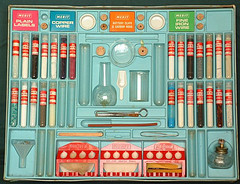Food Chemistry – Basics

Vegetables and fruits constitute an important part of our food. However, these are perishable. In order to prevent their fermentation and decomposition, some chemicals are added to the. All those chemicals which are added to food to improve its shelf life, taste, color and appearance are called food additives.
Classification of food additives
Some important food additives are as follows:
Antioxidants – the foods like potato chips, biscuits, breakfast cereals which contain unsaturated oils and fats undergo deterioration on storage due to oxidation by atmospheric oxygen. To prevent their spoilage, some chemicals are added to prevent their oxidation. The most common antioxidants are butylated hydroxyl tobuene (BHT), butylated hydroxyl anisole and several esters of Gallic acid. The addition to BHA to butter increases its shelf life from months to years. It may be noted that anti oxidants are more reactive towards oxygen as compared to the material they are protecting. Citric acid is also added to get better results.
Artificial sweetening agents– cane sugar and fructose are commonly used as sweetening agents. Some commonly used artificial sweeteners are described as follows:
Saccharin – Saccharin is about 600 times sweeter than sugar. It is insoluble but its sodium salt is soluble in water. It occurs in the form of white crystalline powder. It is not biodegradable and is excreted as such in urine. It has no calorific value.
Cyclamate – it is about 7 times sweeter than sucrose. A mixture of cyclamate and saccharin in the ratio 10:1 is found to be sweeter than either of the two individual compounds.
Aspartame – it is one of the most successful and widely used artificial sweeteners. It is roughly 180 times as sweet as sucrose. It is slowly hydrolyzed in solution and has short shelf life. It cannot be used in drinks.
Sucralose – it is about 650 times as sweet as sucrose. It is trichloro derivative of sucrose and tastes like sucrose. Unlike sucrose, it neither provides calories nor causes tooth decay. It is stable at temperatures used for cooking and baking.
Preservatives– these are defined as chemicals which are capable of inhibiting or arresting the process of fermentation, acidification or any other decomposition of food are called as preservatives. Some commonly used preservatives are as follows:
Sodium Benzoate – it is preferred to benzoic acid as preservative because of its greater solubility in water. It is employed in soft drinks and acidic food. It is metabolized by conversion to hip-uric acid and ultimately excreted in urine.
Sulfur dioxide – the major source of sulfur dioxide is potassium metabisulphite. It inhibits the growth of bacteria, yeast and moulds. It is used in pickles, jams and squashes.
Sodium and Calcium propionate – these are used in bread and cakes to inhibit the growth of moulds.
This article has been compiled by Classof1.com, a leading online Homework-Help provider.
For assistance with your academic assignments in Chemistry, you can visit http://classof1.com/homework-help/chemistry-homework-help
Classof1.com is open 24/7. You can call us at 1-877-252-7763 or drop an email to learning@classof1.com
More Chemistry Articles
